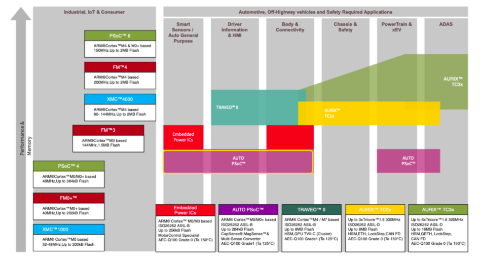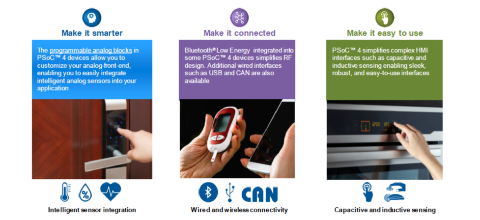PSoC™ 4 - Your Problem Solver on Chip
The Infineon microcontroller portfolio
The Infineon microcontroller portfolio offers a comprehensive range of 32-bit microcontrollers (MCU) based on Arm Cortex and Infineon AURIX TriCore architectures - see Figure 1. Suitable for automotive, consumer, industrial, and IoT applications, they offer a scalable, high-performance, and functional safety-compliant lineup for all your embedded system needs.

This article will highlight the Infineon Programmable System-on-chip (PSoC™) technical specifications and capabilities, specifically emphasizing the PSoC™ 4 family of problem-solving MCUs.
Introducing the programmable and reconfigurable Infineon Programmable System-on-Chip - PSoC™
When it first came to market in the early 2000s, the first PSoC™ MCU, the 8-bit PSoC™ 1, became the world's first microcontroller to feature programmable and reconfigurable digital and analog capabilities, a position the latest generation of PSoC™ products still hold to this day. Based on the trusted and widely adopted Arm Cortex-Mx processor core family, the PSoC™ 4 and PSoC™ 6 products are a fundamental element of the Infineon microcontroller portfolio.
Over the last two decades, embedded system adoption has accelerated considerably. A microcontroller provides the essential computation resource at the heart of an embedded system, but it is certainly not the only crucial component. The MCU relies on receiving data from analog and digital sensors and other peripheral IO signals, requiring function-specific ICs and passive components. Managing the bill of materials (BOM) and supply chain for any product is complicated and increases in complexity the more parts you require.
Overnight, PSoC™ changed the rules of embedded system design by incorporating multiple programmable and reconfigurable analog and digital circuits that could operate independently of the MCU. Rather than juggle with tens of additional analog and digital logic ICs, hardware engineers discovered they could significantly reduce their BOM by using the programmable features inside PSoC™. Reducing the BOM complexity and component cost isn't the only benefit; fewer components require less PCB space, saving valuable space and simplifying the PCB layout.
PSoC™ helps right into production too. Since the programmable functions and the pinout are reconfigurable, the need for PCB rework is virtually eliminated, saving considerable non-recoverable engineering expense, and lost production time.
PSoC™ unique approach to architecting programmable embedded systems continues today with its high-performance, reconfigurable, and BOM-efficient portfolio.
Analog feature blocks include analog-to-digital converters (ADC), low-power comparators, opamps, and digital-to-analog converters (DAC). Using these assets, engineers can design, for example, a low-pass filter and a signal conditioning front-end for an ambient light sensor. Multiple primitive digital logic functions are available in universal digital blocks (UDB) capable of arrangement for a specific logic function or creating a state machine.
PSoC™ 4 - Your problem solver on chip - welcome to the industry's most flexible and scalable low-power mixed-signal architecture
Figure 2 highlights just some of the reasons PSoC™ 4 addresses so many of today's embedded system requirements. Incorporating Infineon's next-generation CapSense capacitive touch sensing and inductive sensing capabilities greatly simplifies integrating a user interface into an application.


PSoC™ 4's comprehensive connectivity options include USB, Bluetooth low energy (BLE), and controller area network (CAN), allowing developers to select the best method for their application. With a host of programmable analog and digital blocks, PSoC™ 4 offers design engineers immense flexibility to create sensor-specific analog front ends or complex digital gating logic, all within the same MCU package, saving BOM count, component cost, and PCB space. You can configure the programmable features using pre-built library functions or create your own using the PSoC™ Creator software.
Figure 3 highlights PSoC™ 4's programmable analog blocks. Each UDB consists of two small PLDs, a datapath module, and status and control logic - see Figure 5. A datapath module has an 8-bit arithmetic logic unit at its heart that can perform increment, decrement, add, subtract, bitwise logic, and shift functions. This combination can quickly implement often-used functions such as counters, PWMs, shifters, UARTs, or I2C interfaces. A UDB Editor is integrated into PSoC™ Creator. Alternatively, a hardware engineer familiar with designing FPGA-based configurations can use Verilog.

The PSoC™ 4 portfolio

Figure 6 showcases the PSoC™ 4 portfolio of programmable SoC MCUs, starting with the entry-level PSoC™ 4000 family up to the PSoC™ 4700 'sense anything' MCU.
PSoC™ 4000 entry-level family
The PSoC™ 4000 and PSoC™ 4000S form a lineup of cost-optimized MCUs with either Arm Cortex-M0 or Arm Cortex-M0+ cores. Clocked up to 48 MHz, up to 32 KB flash, and up to 4 KB SRAM, all parts feature a real-time watch crystal oscillator (WCO) clock. Equipped with CAPSENSE™ capacitive sensing technology, the PSoC™ 4000 family is ideal for implementing low-cost, high-performance user interfaces in wearable and personal care devices using buttons, sliders, and proximity sensors.
Programmable features include:
Analog blocks:
- A 10-bit 11.6 Ksps ADC
- Up to two low-power comparators
- CAPSENSE™ mutual-capacitance sensing
Digital blocks and I/O:
- Up to five timer/counter/PWM (TCPWM) blocks
- Up to two serial configuration blocks
- Up to 36 GPIO

PSoC™ 4100 intelligent analog family
The PSoC™ 4100 adds additional analog and digital blocks, up to 256 KB flash and 32 KB SRAM. The family includes Arm Cortex-M0 and Arm Cortex-M0+ based cores.
Programmable features include:
Analog blocks:
- Up to 12-bit 1 Msps SAR ADC
- Up to six low-power comparators
- Up to four current output iDACs
- Up to four Opamps
- Up to two VDACs
- Infineon CAPSENSE™ with SmartSense auto-tuning
Digital blocks and IO:
- Up to eight Timer/Counter/PWM blocks
- Up to five Serial Configuration Blocks (SCBs)
- Segment LCD drive
- Up to 55 GPIO
Figure 7 highlights the functional architecture of the PSoC™ 4100 intelligent analog family. Typical applications for the family include user interfaces in wearables, home appliances, industrial equipment, and IoT devices.
PSoC™ 4200 - programmable digital family
The PSoC™ 4200 family has an Arm Cortex-M0 core, is capable of up to 48 MHz core speed, a Full Speed USB 2.0 controller, and two CAN interfaces. This family also features up to eight universal digital blocks (UDBs) for creating custom digital functions. The PSoC™ 4200BL integrates a low-power Infineon AIROC Bluetooth low energy (BLE) 2.4 GHz transceiver subsystem and a royalty-free BLE protocol stack.
Programmable features include:
Analog blocks:
- Up to four opamps
- A 12-bit 1 Msps SAR ADC
- Up to six low-power comparators
- Up to four current output iDACs
- CAPSENSE™ with SmartSense auto-tuning
Digital blocks and IO:
- Up to eight Universal Digital Blocks (UDBs)
- Up to eight Timer/Counter/PWM blocks
- Up to four Serial Configuration Blocks (SCBs)
- Segment LCD drive
- Up to 98 GPIO

PSoC™ 4500 - motor and power control family
Featuring a 48 MHz Arm Cortex-M0+ core equipped with two accelerator blocks for division and square-root computation, the PSoC™ 4500 family is optimized for motor control in power tools, home appliances, and industrial applications.
Programmable features include:
Analog blocks:
- Up to three opamps configurable as programmable gain amplifiers or comparators
- Two 12-bit 1 Msps SAR ADCs
- Up to two low-power comparators
- A 7-bit current output iDAC
- CAPSENSE™ with SmartSense auto-tuning
Digital blocks and IO:
- Up to eight Timer/Counter/PWM blocks
- Up to five Serial Configuration Blocks (SCBs)
- Segment LCD drive
- Up to 53 GPIO
The functional block diagram of the PSoC™ 4500 is illustrated in Figure 8.
PSoC™ 4700 - sense anything family
Based around a 48 MHz Arm Cortex-M0+ core and incorporating up to 64 KB of flash and 8 KB SRAM is the PSoC™ 4700 family. Designed for various object detection and user interface applications in consumer appliances and industrial machinery, the family features CAPSENSE™ capacitive and MagSense industry sensing blocks.
Programmable features include:
Analog blocks:
- A 10-bit 1 Msps SAR ADCs
- Up to two low-power comparators
- Two 7-bit current output iDACs configurable as a single 8-bit iDAC
- CAPSENSE™
- MagSense
Digital blocks and IO:
- Up to five 16-bit Timer/Counter/PWM blocks
- Two Serial Configuration Blocks (SCBs)
- Up to 36 GPIO
Automotive PSoC™ 4
Complementing the lineup of consumer and industrial PSoC™ MCUs is the Automotive PSoC™ 4 family. These AEC-Q100 compliant parts accommodate 12 V operation and are ideal for many automotive applications, including cockpit infotainment HMI applications and exterior battery management system (BMS) control applications. Automotive PSoC™ adds automotive-specific interface support such as SENT, LIN, CAN, and CAN-FD, which, together with PSoC™ programmable and reconfigurable features, create a compelling single-chip approach for automotive applications.
PSoC™ 4 application showcase (box-out?)

Printer touchscreen solution requirements (Figure 9)
- A capacitive proximity sensor capable of detecting a person from 1 m to wake up the system
- Implement a low-cost, single layer touchscreen interface with single and multi-touch capability
- Use of on-screen and front panel capacitive touch controls
- A force touch button for inductive sensing

Induction cooktop requirements (Figure 10)
- Implement an integrated main controller solution
- Read multiple sensor inputs
- Control cooktop IGBT drivers, cooling fan, and piezo sounder
- Achieve Class B certification of safe cooktop control
- User interface of
- Touch buttons, sliders, and proximity sensors
- Ability to store multiple cooking profiles in memory
- Touch controls to be liquid-tolerant

Washing machine inverter control requirements (Figure 11)
- A high-performance CPU with comprehensive analog capabilities
- Fast motor control calculations
- Accurate sensing of motor phase currents
- Stable and efficient motor control algorithm
- Achieve safety Class B certification
Getting started with PSoC™ 4
It couldn't be easier to prototype a new design using PSoC™ 4.
First, download ModusToolbox™, which offers concurrent hardware configuration and code development across the complete PSoC™ portfolio. ModusToolbox™ provides an Eclipse-style development environment and integrates everything from board support packages, middleware, and code examples in a since toolchain.
Next, choose from the wide range of PSoC™ 4 development boards. Examples include the PSoC™ 4 Bluetooth LE Pioneer kt (CY8CKIT-042-BLE-A) and the low-cost PSoC™ 4 M-Series Pioneer Kit (CY8CKIT-044)
Select a code sample from over 690 examples to try before creating your first application from scratch. Maybe a tutorial video might help get you started, and don't get the PSoC™ Community is on hand 24/7 to answer any queries you might have.

